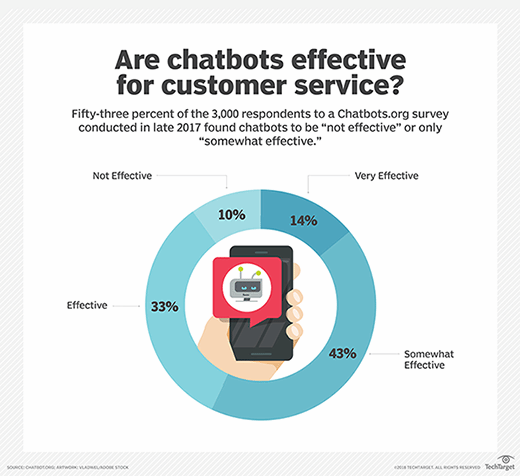
How to deal with the lack of chatbot standards
A lack of standards around chatbot development has created a situation in which enterprises are building and rebuilding bots. But that could change in the near future.
The adoption of chatbots within enterprises resembles the movement of pioneers across the American frontier.
Chatbot developers today are creating unique products without industrywide chatbot standards, leaving the companies that use them on their own as they forge across new digital terrain.
Depending on who you talk to, chatbot ecosystems will eventually become an open, standards-driven environment or will continue to be a winner-takes-all landscape.
"With chatbots, everything is still in the works," Forrester analyst Ian Jacobs said. "There isn't a super-mature anything that I can point to. It's still a fairly new field."
It's not just a matter of one company's chatbot not harmonizing with another company's chatbot. The unruliness also applies to chatbots being developed under the roof of a single organization. Jacobs once advised a company that took an internal survey and found that there were five different chatbot development projects under way. Company leadership turned to Jacobs and asked, "How do we centralize this?" He told them it's all about consistency.
It's all in the API
Despite a lack of industry-accepted chatbot standards, bots tend to fall into a handful of categories.
There are the chatbots that communicate through audio, text or both. Personal assistant chatbots, such as Google Assistant, Apple's Siri and Amazon's Alexa, speak answers and display text and visuals, while also performing a wide array of tasks, like setting an alarm on a mobile device, relaying last night's baseball scores or providing a list of pizza restaurants in your area.
Companies also deploy chatbots on websites and mobile apps to communicate with customers through the written word. Chatbots field basic queries and give quick answers so that customers don't necessarily have to speak with a human representative.

In theory, chatbots should be able to work with one another. To do that, they would need to share an API. The catch is there are probably thousands of commercial and open source APIs because there are at least that many developers. Developers typically stick to their preferred APIs. Companies usually turn to professional services to create a chatbot, although they can also build one of their own through an open source offering. The key to integration is choosing a common API, but there is no universal API standard. With thousands of APIs, many chatbots are solitary figures.
"It is a Wild West right now," said John Sprunger, senior technical architect at consulting firm West Monroe Partners. "There's no standard for integration across bots. The crux of it is passing a context between bots, and that's not happening."
In practice, Sprunger said, this means users can't ask a single chatbot to pull information from several different chatbots to do something like check an account balance, make dinner reservations and get a delivery status update.
Siri, a popular chatbot, can open a banking app on an iPhone, but it won't work in coordination with that bank's chatbot. "Apple forces you to narrow use cases," Sprunger said. "They handle the bot part, and you can't control what Siri says or does. It's a walled garden."
Alexa and Google Assistant, however, offer a more open API and are enabling companies to style their own chatbot skills -- essentially the functions of an app -- on those two chatbot platforms, Sprunger said. Capital One, for example, lets customers manage their accounts through Alexa. Meanwhile, Capital One's own chatbot, Eno, works on its own. That distinction might not bother customers who exclusively use Alexa or Eno. But, on a larger scale, a long list of chatbots aren't on the same page, and that will eventually bug consumers who want integrated services.
The good news is that companies are integrating their chatbots with web applications and devices in products such as smart home systems. "That has been standardized," Sprunger said. A chatbot can communicate with an automated smart home system, enabling a homeowner to shut off the lights, turn down the heat and turn on a television all from one device. "That area is fairly fleshed out," Sprunger added. "The device makers want to work with the chatbot makers and make everything easy."
Integration on the outside and from within
While many companies want to embed their branded chatbots inside popular platforms like Alexa, they're not yet asking for a single set of chatbot standards that would enable them to connect their bot to other branded chatbots, according to Forrester's Jacobs. In other words, banks aren't yet looking to connect their chatbots with a chatbot from a department store -- but they undoubtedly will.
There are many nuances to chatbot integration, which is why the industry will eventually move toward a universal standard in which only one set of knowledge applies and chatbots can work in harmony, Jacobs said. "Brands will want their own chatbots in multiple places, but they won't want to redevelop it for each place," he said.
A need for efficiency will become a major factor in enterprises' chatbot plans. Businesses will want to corral their own chatbots, Jacobs said. Big brands, he said, already have several different chatbots, including one for marketing, a separate one for B2B accounts payable and another for B2C outreach.
"How do you centralize that so there is a consistent user interface even if one chatbot is built by Amazon and another by Microsoft and another by another third party?" he said.
Jacobs anticipates companies will either instruct all of their developers to follow a single set of in-house chatbot standards -- no more freelancing -- or they'll instead outsource to a third-party developer that adheres to a set standard.
"As consumers jump from experience to experience with one company, they'll want consistency in the chatbots," he said.
Some chatbot developers already recognize that need and are now developing a master, or concierge, chatbot that "sits in front and talks to the bots behind it," said Magnus Revang, vice president at Gartner. A few middleware platforms will also manage multiple bots, he said.
"You can orchestrate the whole bunch by setting up the skills differently in the master chatbot so you don't need to train them all," Revang said. "A chatbot talking to a chatbot will be necessary because you don't want 500 different chatbots for different tasks. There will be room for only one master bot in an enterprise. The master bot is the only one that learns. The big software companies, they need to own that master bot in the enterprise, or they will lose the enterprise."
Proprietary needs hold back standards
Steve Worswick, senior AI designer for chatbot developer Pandorabots, thinks he knows why companies haven't been quick to integrate chatbots. It's not because of technical reasons.
"Lots of rival companies don't want to share things," he said. Worswick developed Mitsuku, which won the Loebner Prize, a competition for the most humanlike bot, four times.
He said he can see why companies might take a proprietary approach. If they create a chatbot that's substantially better than existing alternatives, the competition may fall away.
Worswick wants more than simple integration. He would like to see a global network of chatbots. "Chatbots can still do their own thing, but they can also tap into a network, where maybe bots from Italy can pop up and tell you about something going on there. I'm not sure how an internet of bots will be received by the public. It's hard to try to tend to a middle ground."







